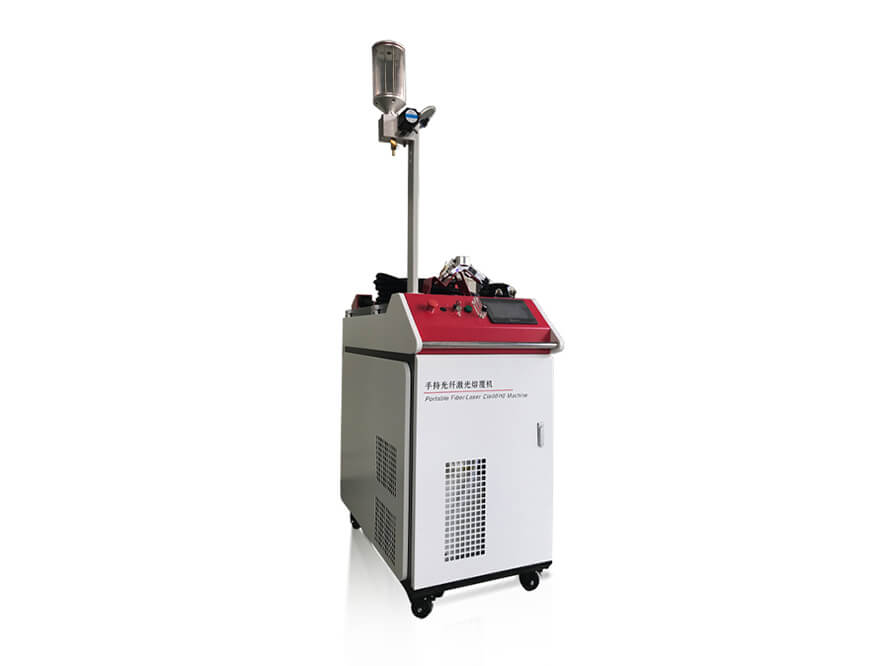Portable Laser Cladding Machine
Portable multifunctional laser cladding machine, compatible with both manual and automated welding equipment. With one-button switching between laser cladding and laser welding, the machine is integrated with devices such as the Powder Feeder. It boasts a high degree of integration, occupies a small footprint, and, thanks to its portable design, is easy to move and flexible to use.
Advantages of the portable laser cladding machine:
- Compatible with the standard QBH interface, ensuring strong universality.
- Uses high-speed elliptical oscillating movement during cladding, increasing the weld seam width in single-pass cladding.
- Incorporates red light scanning technology for cladding positioning, making the operation simple and ensuring precise positioning.
- Utilizes flexible fiber optics for laser transmission, offering long transmission distances, flexible routing, low loss, high practicality, and ease of use to meet our diverse needs.
What is Laser Cladding Technology?
Laser cladding technology harnesses a high-energy laser beam (104-106W/cm²) to irradiate the welding surface and alloy powder, rapidly melting and merging them. As the laser beam departs, the molten material swiftly solidifies, depositing a layer of material with distinct physical, chemical, and mechanical properties on the substrate surface. This process compensates for the inadequacies of the original base material, enabling the creation of surface coatings that are heat-resistant, wear-resistant, corrosion-resistant, anti-oxidant, fatigue-resistant, or possess unique optical, electrical, or magnetic properties. Utilizing laser cladding technology can significantly reduce our product’s material costs. We can produce high-performance products from less expensive materials. Furthermore, based on the varied performance requirements of each part of a product, different cladding materials can be used, ranging from alloy metals to non-metallic materials like ceramics.
Advantages of Laser Cladding Technology:
- Laser cladding technology offers concentrated energy, with both heating and cooling processes being exceptionally rapid. The cooling speed can reach up to 106℃/s. During the swift solidification, it’s possible to achieve fine-grained structures or non-stable phases and amorphous states that can’t be obtained in equilibrium conditions.
- The cladding layer and substrate form a strong metallurgical bond or interfacial diffusion bond, with bond strength comparable to the parent material. The dilution rate of the cladding layer is low, and it can be controlled by adjusting welding focal lengths and melt depths. Moreover, the cladding layer is dense, free from pores, slag inclusions, cracks, and other defects. The thickness and hardness of the cladded layer are highly adjustable, typically ranging from 18 to 60 HRC. Additionally, the beautifully formed cladding layer can reduce the workload of subsequent processing.
- With laser cladding reinforcement and repair processes, only the surface layer of the substrate melts, resulting in a minimal heat-affected zone, typically between 0.1 to 0.5mm. This leads to reduced thermal damage and deformation.
- Laser cladding technology offers virtually no restrictions on the base materials or powder materials used. For instance, high-melting-point alloys can be clad onto the surfaces of low-melting-point metals.
- Lasers can transmit over long distances, making laser cladding technology suitable for on-site repairs of large components that are challenging to move.
- Laser cladding equipment is highly operable and can be used to weld complex shapes or areas like grooves and deep holes, which conventional methods may struggle to access. Especially when using handheld devices, the operational flexibility is further enhanced, allowing for tasks that some automated processes might find difficult to accomplish.
Applicable Laser Cladding Technology:?
The portable laser cladding equipment boasts broad versatility and multifunctionality. It finds applications across various industries in our everyday observations. Examples include: valves, valve seats, sealing flanges, wear-resistant pipes, plunger pumps, straighteners, hydraulic struts, hydraulic cylinders, central grooves in coal mining machines, cutting teeth in coal machinery, and sprockets.
Deewi Automation Technology Co.,Ltd.
We are glad to offer technical solutions to people who are interested in our products. You just need to fill a form.
Get in touch with us today!

